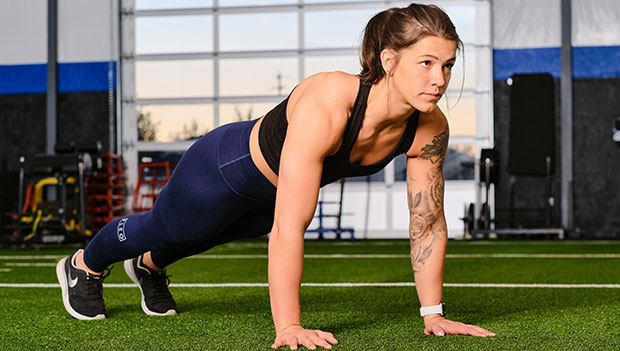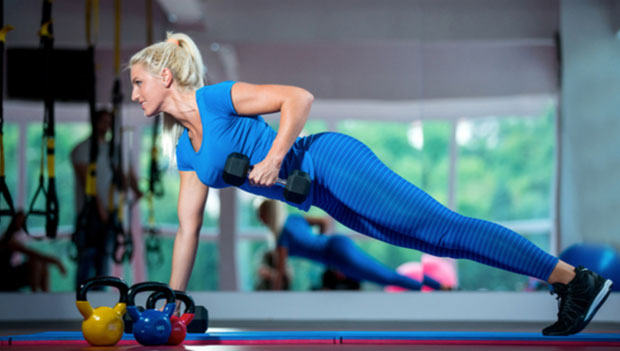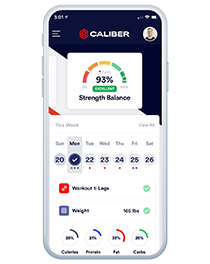
By clicking on the product links in this article, we may receive a commission fee at no cost to you, the reader. Sponsorships and affiliate commissions help support our research so we can help you find the best products. Read the full affiliate disclosure here.
Traditional workout splits can be effective, but they're also time-consuming. And frankly, many of us don't have time to spend an hour or more in the gym 5-6 days per week to target isolated muscle groups. That's OK, because we're going to introduce you to the complete list of full-body exercises that can help you maximize the training time that you do have and set you on the path toward realizing your fitness goals.
Get science-back, personalized training and nutrition directly from a CALIBER COACH:
Benefits of Full-Body Exercises
Very few exercises can truly claim the title "full-body exercise." Plenty of exercises work multiple muscle groups, but when thinking through what to include in a full-body exercise list, movement planes should also be considered. To avoid getting lost in the weeds, let's keep it simple. Your body has three planes of movement, front to back, left to right, and top to bottom. The exercises on this list don't just engage multiple muscle groups, they also create movement across all three of those planes.
Full-body exercises have several benefits, including:
- Combining cardio and strength training into one movement. This is ideal for endurance athletes or athletes who want to see their performance improve.
- These exercises can be of higher intensity and therefore help your body burn more calories and fat in a shorter period of time.
- They can be incorporated into any training routine, whether you have the best training equipment, minimal equipment like a dumbbell set, or no equipment at all.
- A full-body workout can be performed in roughly 30-45 minutes which will save you time in the gym or working out at home.
- They are easily adjustable or customizable by lowering or raising the difficulty, which is also great for accommodating any injuries.
If you're ready to give full-body exercises a shot, the list below can help challenge your body and push your training to new levels.
The Complete List of Full-Body Exercises
Burpee
- Start by standing with your feet about shoulder-width apart.
- Squat down and put your hands on the floor in a push-up position.
- Kick your legs back either by hopping or stepping until your body is in a straight line.
- Perform a push-up, then step your legs forward and lift your hands off the ground to return to a squat.
- Extend your legs, pushing off with your toes to jump straight up in the air with your arms overhead. Land back in the starting position with your knees slightly bent.
Benefits: Burpees are a fat burner, strength builder, and cardio exercise all wrapped into one. They are high intensity and will have you huffing and puffing after a set or two.
Plank

- Start in a push-up position. Your arms should be locked out and your body a straight line from head to toe.
- Lean forward slightly, moving your shoulders just in front of your hands. Hold this position for the allotted time, keeping your back straight and your core tight.
Benefits: Planks are one of the simplest full-body exercises, but simple does not mean easy. In a plank, you will engage almost every muscle in your body to stabilize and hold the pose. For a tougher challenge, lower yourself onto your elbows and forearms.
Hollow-Body Hold
- Lie on your back with your legs straight and your arms extended over your head.
- Lift your legs, arms, head, and shoulders off the ground by pressing your lower back into the ground and tightening your core.
- Hold the pose for the allotted time, keeping your core engaged and your neck neutral.
Benefits: Hollow-body holds are primarily a core exercise, but much like the plank, you'll notice quickly that you have to tighten almost every muscle in your body to hold the pose. If you need to work up to the hollow-body hold, start with v-sits.
Hollow-Body Pull-up
- Start with a shoulder-width overhand grip on a pull-up bar.
- Pick up your feet and squeeze your legs together. Your legs should be fully extended in front of you like a hollow-body hold.
- Pull your chest toward the bar and pause at the top of the movement before returning to the starting position. Keep your legs extended in front of your body throughout the set.
Benefits: Pull-ups are the standard for upper-body strength since the movement requires every muscle in your upper body. However, when you add in the hollow-body hold, your core and leg muscles engage as well, making it a full-body exercise.
Handstand
- Start in a squat position and lean forward until your hands are on the ground.
- Slowly lift your feet off the ground until your weight is resting on your hands.
- Maintaining your balance, slowly extend your legs until they're straight. Hold the pose.
Benefits: Like the pull-up, handstands are an upper-body dominant exercise. However, handstands also require a constantly engaged core and leg muscle chain to be performed properly. The result is a full-body exercise that will test your balance, strength, and endurance all in one movement.
Thruster
- Start by holding a weight at your shoulders in the front rack position. Squat down, keeping the weight stabilized.
- Press the weight overhead as you simultaneously extend your legs to rise from the squatting position.
- Lower the weight back to the front rack position.
Benefits: Thrusters are a very versatile exercise that can be done with a dumbbell, kettlebell, barbell, or any item you can hold in two hands and feel comfortable lifting over your head. Thrusters activate muscles in all major muscle groups while also challenging your cardiovascular system, which means this exercise is a fat incinerator.
Man-Maker

- Start in a standing position holding a dumbbell in each hand. Set the dumbbells on the ground and kick your feet back until you're in a push-up position with your hands on the dumbbells.
- Perform a push-up by lowering your chest to the ground and pushing back up until your arms are fully extended.
- Perform a single-arm row with the dumbbells, one with each arm.
- Step your feet back under your torso and lift the weights into the front rack position.
- Press the weights overhead as you stand up from the squat position.
Benefits: Simply reading the instructions for man-makers leaves you out of breath! This movement is a combination of a burpee, a renegade row, and a thruster. In some ways it is the ultimate full-body exercise because it engages almost every muscle in your body from your toes to your shoulders.
Turkish Get-Up
- Lie on your back with one leg bent. With the same-side hand, hold a weight over your chest with your arm straight.
- Keeping the weight up, lift your upper body up to balance on your elbow, then straighten your arm and lift your hips off the ground so you're balancing on your hand and the side of your foot.
- Step your other foot back and place your knee on the ground under your hips, lifting your hand off the floor so you're in a half-kneeling position.
- With the weight still held straight overhead, straighten both legs and step your back foot forward to end in a standing position with your feet together.
- Perform the movement in reverse to return to the starting position.
Benefits: The Turkish get-up is a difficult exercise to master, but the benefits are off the charts. You are training your legs, core, arms, shoulders, back, balance, and cardiovascular system with limited impact on your joints. Since this exercise is so complex, it's recommended that you perform it with just body weight until you get the movement down before trying it with a dumbbell or kettlebell.
Deadlift

- Start with the weight on the ground in front of you.
- Slightly bend your knees and hinge at the hips to pick up the weight.
- Engage your glutes as you straighten up, pulling the weight off the floor and up your shins as you return to standing. Keep your arms and back straight throughout the movement.
- With control, lower the weight back to the floor to reset for the next rep.
Benefits: Deadlifts work through your hips, abs, and lower back, but the rest of your muscles are engaged throughout the movement, too. When done properly, deadlifts will make you feel strong and help strengthen your stabilizing muscles to improve your performance in the rest of your exercises.
Clean and Press
- Start with the weight on the floor in front of your shins.
- With your knees slightly bent, grip and lift the weight up your body to the front rack position in one smooth motion.
- Press the weight overhead until your legs and arms are fully extended.
Benefits: The clean and press uses all of the major muscle groups from your feet to your shoulders to complete the movement. The first half—from floor to front rack position—targets your legs, core, and hips. The second half of the movement, the overhead press, targets your arms, chest, back, and core.
Snatch
- Start with a barbell on the floor in front of your shins.
- Bend your knees and hinge your hips back into a squat and grip the bar with a wide grip, almost as far as the bar will allow.
- Keep your back flat and core tight as you stand, lifting the weight up your body in one motion from the floor to your hips.
- When the bar reaches your hips, shrug your shoulders and drop into a squat, simultaneously bringing the barbell to an overhead position with your arms fully extended.
- Keep the weight stabilized overhead as you straighten your legs into the standing position.
Benefits: The snatch is a dynamic exercise that requires your body's muscle groups to work together to control and balance a weight in motion. When incorporated correctly, the snatch will improve joint mobility, core stabilization, and overall strength. This is an advanced move, so try practicing it with a broom handle, PVC pipe, or empty barbell before you try it with weight. You can also try one of the snatch variations that use a dumbbell or kettlebell rather than a barbell.
Final Takeaway
There are a lot of benefits to full-body training, from saving time to improving performance by allowing you to do strength training and cardio simultaneously. Not many exercises challenge your full body, so we hope you will give the exercises on our list a try. If full-body training interests you, we encourage you to check out our 6-Week Full-Body Workout Plan to really challenge yourself.
Full-Body Exercises | Full-Body Workouts | Full-Body Dumbbell Workouts | Full-Body Workouts At Home | Bowflex Home Gym | Best Functional Trainers



